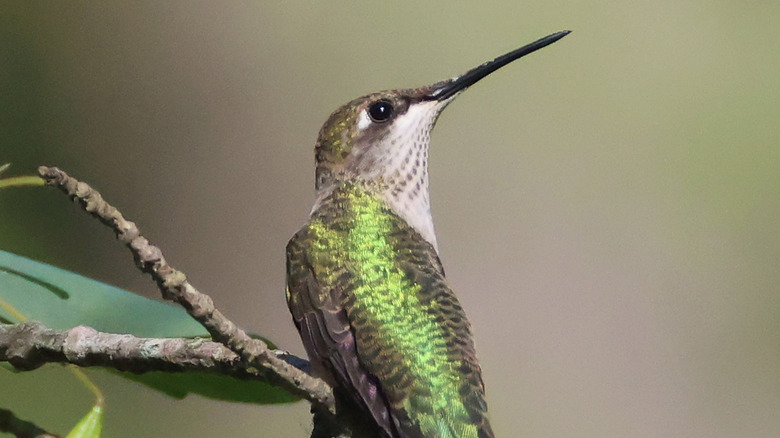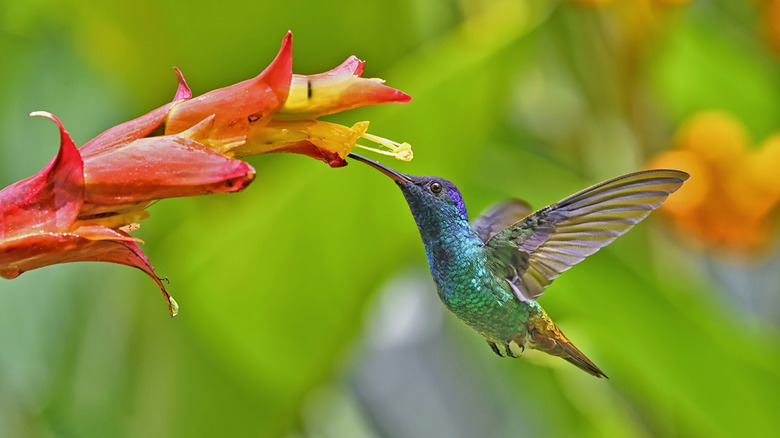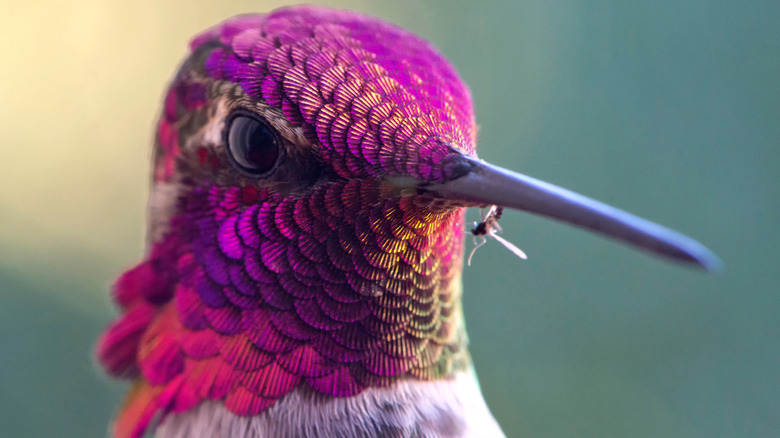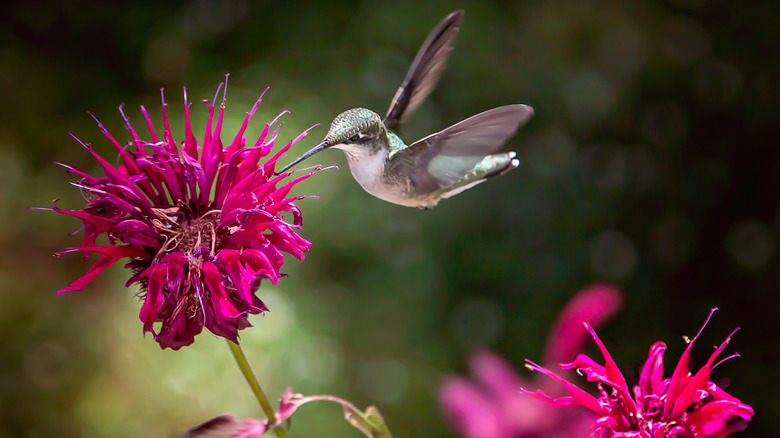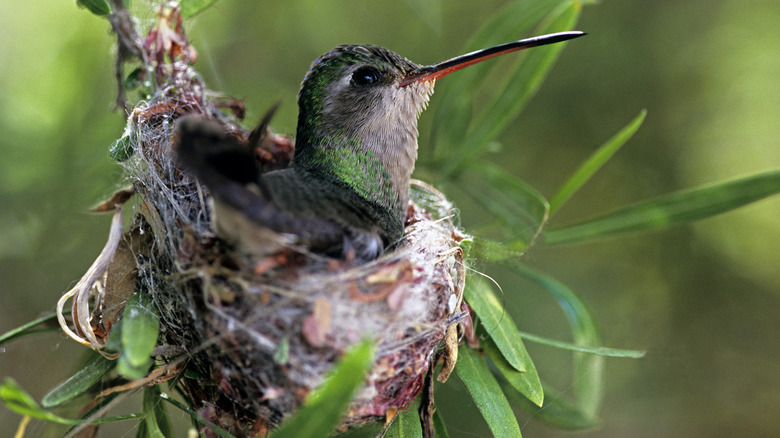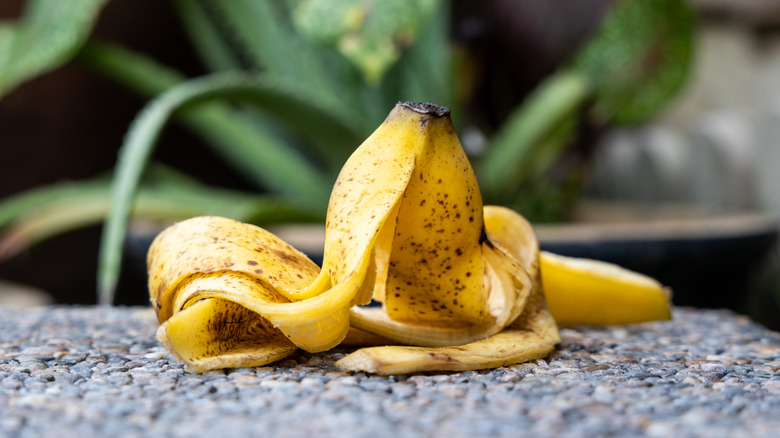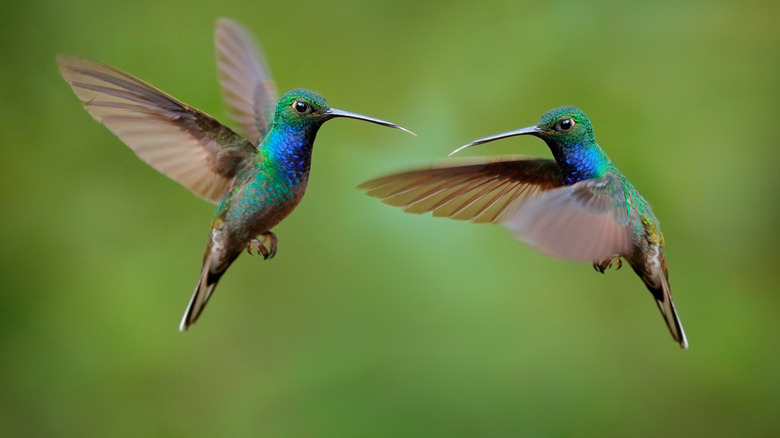Surefire Ways To Attract Hummingbirds To Your Yard Without A Feeder
Hummingbirds are among some of the most popular birds in the United States. Not only do they sport beautiful-colored feathers, but their tiny sizes and fast speeds continue to fascinate birdwatchers of all ages. When you consider how fast those wings move, though, it's perhaps no surprise that hummingbirds eat in 10-to-15-minute intervals — which ultimately means they need to have reliable sources of food for their survival.
While you might be tempted to put up a nectar-containing feeder to attract hummingbirds, there are several other reliable methods to help draw these birds to your yard. In fact, a hummingbird feeder should be considered a secondary method to other hummingbird-attracting options. These can include a range of flowers and bugs, as well as bright colors to entice them. When attracting hummingbirds, it's also just as important to consider eliminating certain things from your yard, including keeping predators and chemicals that can harm them. These same principles are true even if you already have a feeder, but are not having much luck attracting hummingbirds with nectar alone: With a little bit of planning and variety, you might finally get to enjoy hummingbirds in your yard after implementing these strategies.
Attract hummingbirds with the color red
Hummingbirds love bright colors, but they seem to be especially attracted to the color red. This is due to the fact that hummingbirds associate red with nectar-rich flowers of the same color. So even if you don't have flowers in your yard, simply having red-colored items can potentially entice these birds to enter your space and see what items you have to support them. This is also a great strategy for attract hummingbirds if just setting out a feeder out hasn't been doing the trick.
There are several ways you can attract hummingbirds with the color red, with the most obvious being that you can plant a variety of red-colored flowers around your yard. Other potential items that people have tried include red ribbons, tape, or garden flags. However, if you do possess a hummingbird feeder, there's one important way to not apply this advice: Never add red food coloring to the nectar, as this is not necessary, and the chemicals can harm them.
If you want hummingbirds, you also want (some) pests
Do you employ an aggressive approach toward pest control in your yard? Well, unfortunately, this could be a big reason why you're not seeing hummingbirds.
Contrary to popular belief, these birds don't eat just nectar. While nectar-containing flowers are indeed important food sources for these high calorie-burning birds, they also need protein. This is where bugs can help round out their diets. Among some of the most important protein sources for hummingbirds include aphids, mosquitoes, gnats, flies, beetles, and even the occasional spider. A lack of protein sources in your yard, then, could make it not a very appetizing place for hummingbirds.
Controlling pests while simultaneously attracting hummingbirds can seem like a tricky needle to thread, but it's not impossible. First, you'll want to avoid using insecticides to repel pests: Not only do they deter hummingbird activity, but can hurt them. You'll particularly want to stop spraying them around nectar-producing flowers and other areas of your yard that hummingbirds might frequent. From there, one potentially clever approach is place insect-repelling plants near points of entry to your home. Examples include lavender, mint, rosemary, sage, and basil plants, which all have fragrances that may be off-putting to a variety of pests. Such plants can help repel mosquitoes and other insects, while keeping them outdoors — and thus, ready to become perfect prey for any hummingbird visitors.
Plant hummingbird-friendly flowers
A hummingbird feeder with either commercial or homemade nectar isn't the only way to provide these tiny birds with the sugar they need. An all-natural alternative is to plant hummingbird-friendly flowers. In fact, hummingbirds feed from 1,000 to 2,000 flowers every day!
Not only might these flowers attract hummingbirds to your yard, but they can also add some color to your yard or garden. In particular, hummingbirds are attracted to native plants with bright colored flowers, such as red, orange, and yellow. Tubular-shaped flowers are also considered particularly attractive to hummingbirds because they can easily feast from their little cuplike shape, and they tend to hold more nectar than other flower shapes.
That said, there are hundreds of types of flowering plants that can attract hummingbirds. Some of the most attractive types include trumpet vine, bee balm, and butterfly weed. If you're wanting to create opportunities to watch hummingbirds feed from nectar-producing flowers, consider planting them from lowest to highest. You can also consider plants that are easy for beginners to care for, such as begonias. Above all else, variety is key when it comes to attracting hummingbirds with flowers, so try to incorporate multiple types of flowering plants, shrubs, and small trees, as well as flowers with varying blooming times, so you can support hummingbirds throughout as much of the year as possible.
Preserve spiderwebs for the hummingbirds
Your first impulse when seeing a ton of spiderwebs draped around your property would be, most likely, to rip them all down — lest you may become an "instant ninja" after accidentally walking into one. However, just as aggressive pest control could deter hummingbirds from hanging out in your yard, they may also be more likely to hang out in yards that have spiderwebs. During nesting season, hummingbirds rely on spiderwebs for their silk to help build nests, when they're not eating the spiders themselves.
While too many spiderwebs can become a nuisance, you can help support hummingbirds create and repair nests by making sure you leave some of these webs alone. It's perfectly reasonable to remove spiderwebs that cover entry points into your home, of course, but try not to mess with ones away that are from your house, such as those that are spun in bushes or trees. As an important caveat, though, do be sure to remove spiderwebs from around the vicinity of any feeders or nectar-containing flowers so hummingbirds don't accidentally fly into them and get trapped.
Don't let your cat scare hummingbirds away
Chances are, you're not the only one in your household that may be interested in checking out hummingbirds in your yard. Cats are also particularly fond of birdwatching, as well as hunting them if they're given the chance. Unfortunately, their fascination is a bit more malicious than ours, as it turns out that cats are generally ranked as the number one predator of hummingbirds. When our feline friends encounter hummingbirds, the results can be devastating for the birds, and disappointing for the humans who are trying to feed them. It's even thought that cats have played a role in decreasing population numbers in certain hummingbird species.
While you can't necessarily control other predators of hummingbirds, such as hawks, a domesticated cat roaming around your property will likely deter hummingbirds from entering your yard space altogether. The best way to keep hummingbirds safe is to make sure you keep all cats indoors. Another method is to ensure that hummingbird food sources are high off the ground to provide space between them and feral cats — or your neighbors' cats, if they have an outdoor pet roaming the neighborhood.
Strategically use fruit to help attract hummingbirds
If you're still not seeing any hummingbird activity despite your best efforts, you might consider the help of fruit. In particular, it's thought that overripe fruit and banana peels may both be effective methods in drawing hummingbirds to your yard or garden. These birds aren't attracted to the actual fruit, but the bugs — particularly fruit flies — certainly are. The presence of such insects may then entice hummingbirds to stop by your yard to gain access to this protein-rich food source, because as we covered earlier, hummingbirds love pests. And as a perfect bonus, banana peels may also serve as great plant food.
To implement this method, consider using banana peels (or any overripe fruit you don't plan on eating) and strategically place them around your yard. Consider placement near locations where you're trying to attract hummingbirds, such as feeders, flowers, or water sources. The fruit will ultimately attract fruit flies, and hopefully the hummingbirds will follow. To keep things clean on the ground, you can add these items in a hanging basket and dispose of the contents as needed.
Provide hummingbirds with as much space as possible
By now, while you might have placed any number of items in your yard to attract hummingbirds, it's important to balance these all out with space — because in the end, they'll need enough room to fly around and see that your property is safe for them. Having too many plants, red items, and fruit baskets may end up having the opposite effect of what you intend. This is because while hummingbirds will likely use your yard for food, shelter, and water, if they feel crowded-out, they may not consider the space safe.
If you do decide to put up a hummingbird feeder, keep it in a separate area from other types of feeders you might have for songbirds. Also, since hummingbirds are known to be feisty with one another, you may need to consider having multiple feeders and flowers spaced around your yard to give everyone ample elbow room. For the best results, space feeders a minimum of 15 feet apart from each other, but further is better. If you have space by your windows for feeders, consider placing each feeder at different windows at different areas of the house, as not only will this separate the birds from one another, but will also allow for prime hummingbird viewing from inside your home.
